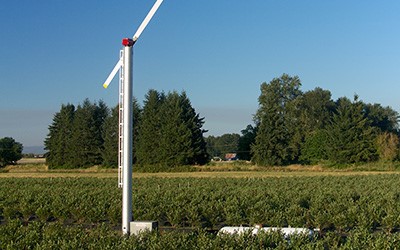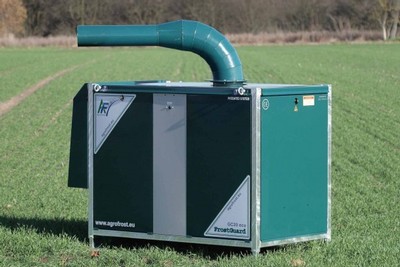Frost Protection for Texas Grapes – 2019 Update
In April, 2017, following a trip to the Texas High Plains, Carl’s Corner addressed the topic of protection for grapes from spring frosts and methods available to mitigate freeze damage to young vine tissue and grapes. Texas in general, especially the High Plains, is noted for turbulent and unpredictable weather that often brings frigid temperatures soon after bud break when grapevines are most susceptible to frost damage. Just in the past week or so we have experienced overnight temperatures in the low twenty-degree range here in the Texas Hill Country. This has raised serious concerns for not only grapevines but peach trees, too. Posts on Facebook and Instagram have highlighted these concerns, and just in the past few days limited information has become available about the damage that was or was not observed. More on this part later.
Four methods of commonly used frost protection are described below. Please note that none of these are fool-proof, and all are expensive, unfortunately adding cost to Texas grapes, and therefore to Texas wines.
Wind machines are now installed in many Texas vineyards. These two-blade fans are mounted on a column and are driven by a motor that runs on diesel, gasoline, natural gas or propane. The fans are designed to rotate in a circular pattern, pushing warmer air from above the vineyard down into the grapevines. Remember that warm air rises and cold air sinks, so when frigid weather occurs, it will be colder down low near the fruiting zone of the vines. These wind machines turn on automatically when the temperature reaches a selected set-point, usually just below freezing. Each machine is designed to protect a certain area within a vineyard. A grouping of machines is required to protect larger vineyards. If the vineyard is on a slope, machines are set to push cold air downhill. As you visit Texas vineyards, you will likely see these wind machines standing ready to protect our state’s precious grape crops.

A wind machine that runs on propane, photo from the Orchard-Rite website
A frost protection furnace is another tool being used by Texas grape growers. These furnaces burn fuel, usually propane, to heat air that is blown into the vineyard through a large vent tube. Most vineyard machines have the circulating vent tube mounted on top of the furnace so that hot air does not scorch nearby grape leaves or fruit. Similar machines used in orchards typically have the vent tube mounted low to blow under the trees. Frost protection furnaces generate warm air to help mitigate frost damage, whereas wind machines generally depend on ambient warmer air to help protect the vines.

2) Frost Guard furnace with rotating vent tube, photo from Southwest Ag Specialties website.
A third method of frost protection that was new to me involves heating small metal pyramids, about 3 ft tall and 2 ft square at the base. A grouping of these pyramids are placed at 30-60 ft intervals in the vineyard, and heated with small propane burners placed underneath. As the metal is heated, warm air radiates outward, rising through the vines to displace cold air. This method appears to be very effective, but requires more labor than the two above. Workers must set out the pyramids when frigid temperatures are predicted, and the small burners underneath have to be individually ignited when temperatures drop, usually very early in the morning. This method also requires an extensive tubing/piping system in the vineyard to deliver propane to the burners.
The fourth method of frost protection noted here is an old fashioned one – burning something near the vineyard to provide warm air. Wood piles of pruned vines or orchard tree limbs can be used. Bales of hay are a common fuel source today. And smudge pots that contain heavy oil can be ignited, although smoke emissions from these are often not allowed in certain areas. Again, these methods are labor intensive, and there is no guarantee that the warm air generated will actually go into the vineyard to displace the damaging cold air. If the wind is blowing, the heat sources are set at the upwind side of the vineyard, or if no wind is blowing, the heat sources are set on the downhill side of the vineyard with the goal that warm air will rise through the vineyard.
So, what has happened to our grapes (and peaches) during the frigid temperatures experienced the first week of March, 2019? Vines and trees that budded out early, prompted by spring-like warmer temperatures in February, were damaged to a considerable extent. Sometimes secondary or even tertiary buds can survive and still create some fruit, but the crop will certainly be reduced in both quantity and quality. Many later developing grape and peach varieties had not yet budded out, and remained in a more dormant state. For these, there is hope that little or no damage to the 2019 crop occurred. Even lower temperatures were seen in north central Texas and on the Texas High Plains. Most vines had not reached bud stage and were, hopefully, not damaged. But, there is anticipation that some “winter kill” damage to less sturdy canes and vines may have occurred due to temperatures in the low teens and even single digits. It will be a few weeks before growers can develop a full appreciation of the cold damage, and with the vagaries of Texas weather, we may not be out of frost danger for another month or so.
I am continually amazed and my spirit uplifted by the dedicated souls that grow grapes in Texas. Any type of farming is hard work, but these grape growers are willing to make the extra effort, and pay the significant cost required for frost protection so that we can have grapes to make Texas wine. The next time you visit a vineyard or tasting room, ask about frost protection and give a sincere supportive “thank you” to those who are working so hard for the Texas Wine Industry.
